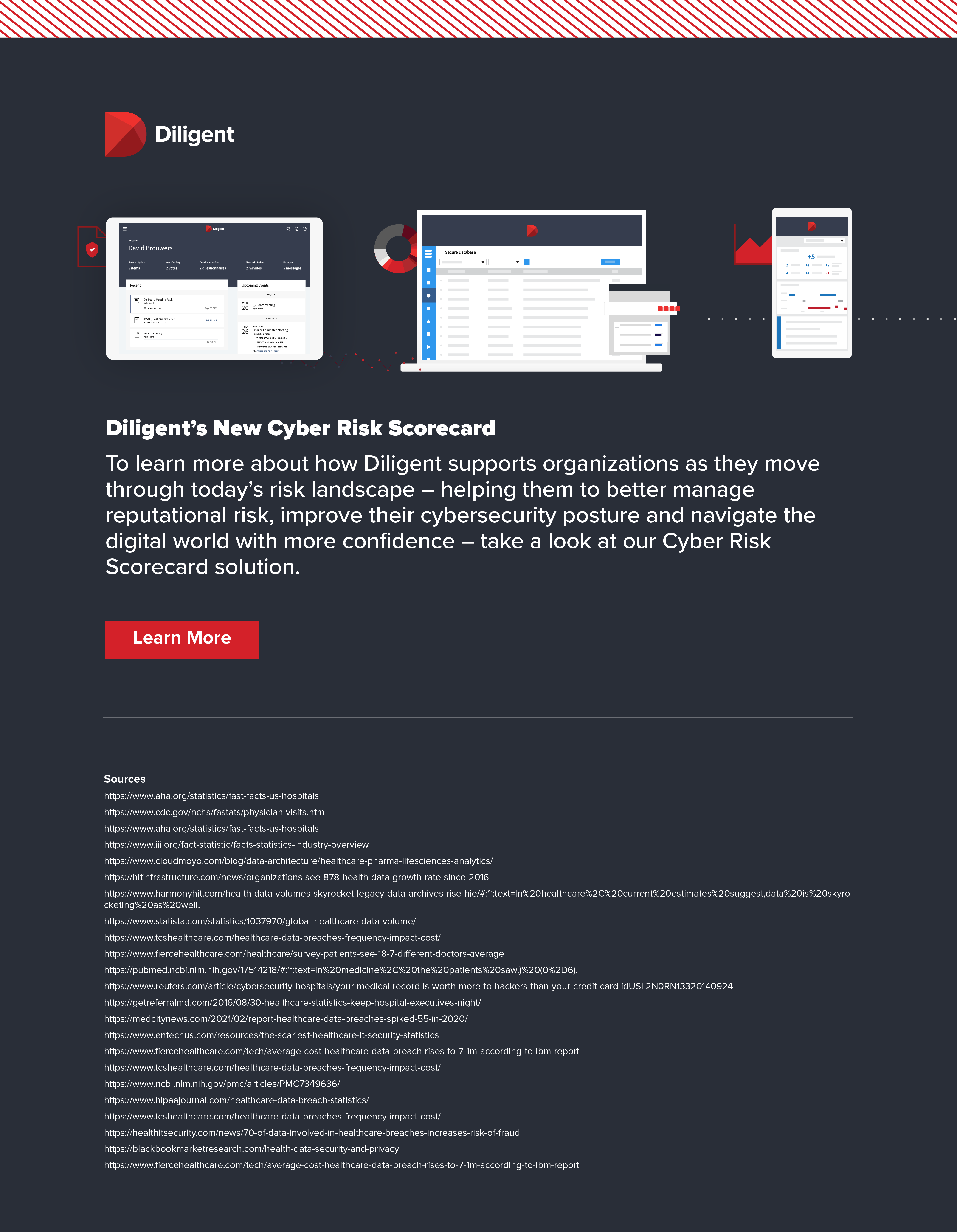Healthcare data in the USA, by some estimates, is up to 20 times more valuable to cybercriminals than a credit card number. The enticing combination of personal and financial information makes electronic medical records a gateway to blackmail or identity theft, allowing a criminal to build an entire human persona around one record. Given the rapidly evolving nature of medical care, it can be difficult for organizations to ensure their defenses are strong enough - leaving sensitive patient information vulnerable to breaches.
As critical as cybersecurity is for modern healthcare systems, it's not simply a case of encrypting data and communications. Healthcare organizations must invest in security solutions that remain effective across any number of digital health use patterns.
By utilizing a digitally driven approach to governance, healthcare boards, leadership teams and organizations can stay vigilant against the threat of cyberattacks. Below, we break down the healthcare data challenge in numbers - the problems it faces, the ramifications of those problems, and what a good solution looks like.
 When it comes to crunching the numbers, the sheer volume of information the healthcare industry has to care for is quite staggering. With the American population so reliant on the healthcare system to function fluidly, it's integral that all the right checks and balances are in place.
When it comes to crunching the numbers, the sheer volume of information the healthcare industry has to care for is quite staggering. With the American population so reliant on the healthcare system to function fluidly, it's integral that all the right checks and balances are in place.
 Given the size and scope of the healthcare industry in the USA, it's no surprise that these numbers are so large - or that the vulnerabilities organizations face are so acute. As custodians of particularly confidential and sensitive data, it's essential that healthcare organizations ensure they have the right structures in place not only to manage it but to keep it secure.
Given the size and scope of the healthcare industry in the USA, it's no surprise that these numbers are so large - or that the vulnerabilities organizations face are so acute. As custodians of particularly confidential and sensitive data, it's essential that healthcare organizations ensure they have the right structures in place not only to manage it but to keep it secure.
 Let's be clear - all organizations, no matter the industry, are subject to breaches and risks. But the intrinsic value of healthcare data, coupled with the size of some hospitals, complicated board structures and a reliance on legacy systems, makes it particularly vulnerable. The impact of those vulnerabilities becomes even more stark when we see just how much of a risk cyber breaches can present.
Let's be clear - all organizations, no matter the industry, are subject to breaches and risks. But the intrinsic value of healthcare data, coupled with the size of some hospitals, complicated board structures and a reliance on legacy systems, makes it particularly vulnerable. The impact of those vulnerabilities becomes even more stark when we see just how much of a risk cyber breaches can present.
 Despite the picture painted by the numbers above, all is not lost. Healthcare boards can implement processes and practices that will go a long way to protecting themselves against bad actors.
Cybersecurity is, and will remain, the biggest challenge many healthcare institutions face. And while it may not be possible to prevent all cyberattacks, thoughtful steps towards mitigating risk and a plan to address attacks when they do happen will ensure leaders are stewarding their companies effectively through the years to come.
Despite the picture painted by the numbers above, all is not lost. Healthcare boards can implement processes and practices that will go a long way to protecting themselves against bad actors.
Cybersecurity is, and will remain, the biggest challenge many healthcare institutions face. And while it may not be possible to prevent all cyberattacks, thoughtful steps towards mitigating risk and a plan to address attacks when they do happen will ensure leaders are stewarding their companies effectively through the years to come.
 Through its modern governance platform and expertise with the concerns of healthcare organizations, Diligent supports organizations both big and small as they navigate today's risks. Read more in Diligent's New Cyber Risk Scorecard.
Through its modern governance platform and expertise with the concerns of healthcare organizations, Diligent supports organizations both big and small as they navigate today's risks. Read more in Diligent's New Cyber Risk Scorecard.
_________________________
The Simple Facts
 When it comes to crunching the numbers, the sheer volume of information the healthcare industry has to care for is quite staggering. With the American population so reliant on the healthcare system to function fluidly, it's integral that all the right checks and balances are in place.
When it comes to crunching the numbers, the sheer volume of information the healthcare industry has to care for is quite staggering. With the American population so reliant on the healthcare system to function fluidly, it's integral that all the right checks and balances are in place.
The Raw Data
 Given the size and scope of the healthcare industry in the USA, it's no surprise that these numbers are so large - or that the vulnerabilities organizations face are so acute. As custodians of particularly confidential and sensitive data, it's essential that healthcare organizations ensure they have the right structures in place not only to manage it but to keep it secure.
Given the size and scope of the healthcare industry in the USA, it's no surprise that these numbers are so large - or that the vulnerabilities organizations face are so acute. As custodians of particularly confidential and sensitive data, it's essential that healthcare organizations ensure they have the right structures in place not only to manage it but to keep it secure.
Vulnerabilities Laid Bare
 Let's be clear - all organizations, no matter the industry, are subject to breaches and risks. But the intrinsic value of healthcare data, coupled with the size of some hospitals, complicated board structures and a reliance on legacy systems, makes it particularly vulnerable. The impact of those vulnerabilities becomes even more stark when we see just how much of a risk cyber breaches can present.
Let's be clear - all organizations, no matter the industry, are subject to breaches and risks. But the intrinsic value of healthcare data, coupled with the size of some hospitals, complicated board structures and a reliance on legacy systems, makes it particularly vulnerable. The impact of those vulnerabilities becomes even more stark when we see just how much of a risk cyber breaches can present.
Help At Hand
 Despite the picture painted by the numbers above, all is not lost. Healthcare boards can implement processes and practices that will go a long way to protecting themselves against bad actors.
Cybersecurity is, and will remain, the biggest challenge many healthcare institutions face. And while it may not be possible to prevent all cyberattacks, thoughtful steps towards mitigating risk and a plan to address attacks when they do happen will ensure leaders are stewarding their companies effectively through the years to come.
Despite the picture painted by the numbers above, all is not lost. Healthcare boards can implement processes and practices that will go a long way to protecting themselves against bad actors.
Cybersecurity is, and will remain, the biggest challenge many healthcare institutions face. And while it may not be possible to prevent all cyberattacks, thoughtful steps towards mitigating risk and a plan to address attacks when they do happen will ensure leaders are stewarding their companies effectively through the years to come.
The Solution
 Through its modern governance platform and expertise with the concerns of healthcare organizations, Diligent supports organizations both big and small as they navigate today's risks. Read more in Diligent's New Cyber Risk Scorecard.
Through its modern governance platform and expertise with the concerns of healthcare organizations, Diligent supports organizations both big and small as they navigate today's risks. Read more in Diligent's New Cyber Risk Scorecard.
Discover Your Cyber Risk Score

Media Highlights
Environmental, social and governance (ESG) issues have become more complex and multifaceted than ever before. At the same time, ESG continues to ascend on board and leadership agendas.
In this buyer’s guide, we explore what a market-leading ESG solution should look like and highlight the key areas organisations should be prioritising as they embark on their search.




